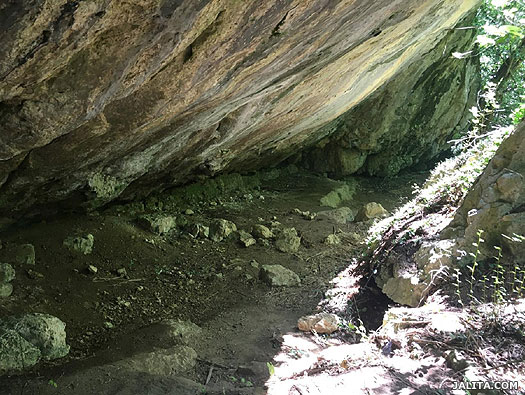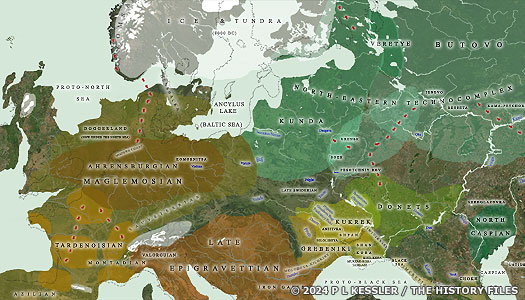 |
|
| (Information by Peter Kessler, with additional information from The Magdalenian Settlement of Europe, Quaternary International Volumes 272-273 (2012), and from External Links: The Palaeolithic of the Western Steppe Zone, Karol Szymczak (Reference Module in Social Sciences, 2023, available via Science Direct), and Early Mesolithic (Indo-European.eu), and Radiocarbon Chronology of the Final Palaeolithic, Mesolithic and Neolithic of Crimea, A A Yanevich (Vita Antiqua 11, 2019, Archaeology, Museum & Monument Studies: educational and research aspects), and The Genetic History of Ice Age Europe (Nature 2016), and The Epigravettian chronology and the human population of eastern Central Europe during MIS2, György Lengyel (Lead Author, Quaternary Science Reviews Volume 271, 1 November 2021, available via Science Direct).) |
|
| c.13,000 BC |
With its type site at the Shan Koba cave in Crimea, the Shan Koba culture seems to emerge out of the fading regional domination of the Magdalenian culture (although Epigravettian influence cannot be ruled out). In time it evolves alongside an increasing number of other Epi-Palaeolithic and early Mesolithic cultures which occupy small pockets of territory in the Black Sea coastal area.  The Shan Koba type site cave was discovered during explorations in 1927 by S A Trusova and S N Bibkov, while field research was carried out in 1927-1928 by G A Bonch-Osmolovsky, and in 1935-1936 by the returning S N Bibikov and S A Trusova The Shan Koba type site cave was discovered during explorations in 1927 by S A Trusova and S N Bibkov, while field research was carried out in 1927-1928 by G A Bonch-Osmolovsky, and in 1935-1936 by the returning S N Bibikov and S A Trusova |
| c.10,000 BC |
Crimea quickly becomes a patchwork of co-existing cultures. Some emerge on plains Crimea, such as the Kukrek and Olexiivka, while others are focussed on mountain Crimea of the south, including the Shan Koba, the newly-emergent Tash-Air, and a latecomer in the Murzak-Koba. The Kizil-Koba (I) culture soon emerges in the foothills of eastern Crimea. |
| c.9700 BC |
 The Younger Dryas has seen a temporary return to glacial conditions, although not uniformly around the world, or even in Northern Europe (and see feature link). The fading of its last stages around this time sees the gradual reintroduction of trees across the northern tundra and improvements to life for modern humans in Southern Europe. Perhaps making the most of such improvements, the hunters of the Swiderian culture are frequent visitors to the equally treeless Crimea for the next millennium and-a-half. This suggests that the region has suffered from the cold snap and the Shan Koba people have weakened in their Crimean dominance. The Younger Dryas has seen a temporary return to glacial conditions, although not uniformly around the world, or even in Northern Europe (and see feature link). The fading of its last stages around this time sees the gradual reintroduction of trees across the northern tundra and improvements to life for modern humans in Southern Europe. Perhaps making the most of such improvements, the hunters of the Swiderian culture are frequent visitors to the equally treeless Crimea for the next millennium and-a-half. This suggests that the region has suffered from the cold snap and the Shan Koba people have weakened in their Crimean dominance.  The Younger Dryas cold spell hit North America hard, just when things were starting to warm up at the end of the ice age - not only did many of the large mammals die out but so did the Clovis culture (click or tap on image to view full sized) The Younger Dryas cold spell hit North America hard, just when things were starting to warm up at the end of the ice age - not only did many of the large mammals die out but so did the Clovis culture (click or tap on image to view full sized) |
| c.9000 BC |
The first typically Mesolithic flint-knapping tradition - the Bilolissya - appears in the lower Danube region at the Dryas III-Preboreal boundary. Its people have migrated from Dobrudja (in Bulgaria) as they follow aurochs, their main hunting species. This tradition, or culture, is seen by some experts as being part of the Shan Koba rather than a culture in its own right. The Crimean Kizil-Koba (I), however, is not. |
| c.8000 BC |
The Tsarinka-Rogalik tradition or culture emerges in the early Mesolithic period (potentially as part of the Shan Koba), although no direct dates are currently available. The Dryas III-Preboreal period in this region above the Black Sea is characterised by aridisation - a general drying out and a resultant decrease in plant life.  Although culturally and technologically continuous with Palaeolithic cultures, Mesolithic cultures quickly developed diverse local adaptations for special environments, as this map shows (click or tap on map to view full sized) Although culturally and technologically continuous with Palaeolithic cultures, Mesolithic cultures quickly developed diverse local adaptations for special environments, as this map shows (click or tap on map to view full sized) |
| Human groups in the centre of this region, part of the Anetivka late Palaeolithic flint-knapping technology, have been broken up by the changes, forced to disperse to more habitable locations which may also include Shan Koba territory in Crimea. The people of the Tsarinka move in to make the most of the extra hunting space, while the Anetivka people soon give birth to the more widespread Kukrek tradition. |
|
| c.5700 BC |
The Shan Koba type site exhibits its last influences around now, suggesting that it has most definitively now been succeeded by the Kukrek culture. In nearby Eastern Europe the relatively unknown Bilolissya has already long since faded, while the Tsarinka-Rogalik may only just have turned into the widely-dominant Grebeniki culture. |
 |
|
 Archaeological finds are constantly being made, and archaeological cultures are frequently being updated with new information. Get in touch here if this page also requires updating.
Archaeological finds are constantly being made, and archaeological cultures are frequently being updated with new information. Get in touch here if this page also requires updating.
 The Shan Koba type site cave was discovered during explorations in 1927 by S A Trusova and S N Bibkov, while field research was carried out in 1927-1928 by G A Bonch-Osmolovsky, and in 1935-1936 by the returning S N Bibikov and S A Trusova
The Shan Koba type site cave was discovered during explorations in 1927 by S A Trusova and S N Bibkov, while field research was carried out in 1927-1928 by G A Bonch-Osmolovsky, and in 1935-1936 by the returning S N Bibikov and S A Trusova The Younger Dryas has seen a temporary return to glacial conditions, although not uniformly around the world, or even in Northern Europe (and see feature link). The fading of its last stages around this time sees the gradual reintroduction of trees across the northern tundra and improvements to life for modern humans in Southern Europe. Perhaps making the most of such improvements, the hunters of the Swiderian culture are frequent visitors to the equally treeless Crimea for the next millennium and-a-half. This suggests that the region has suffered from the cold snap and the Shan Koba people have weakened in their Crimean dominance.
The Younger Dryas has seen a temporary return to glacial conditions, although not uniformly around the world, or even in Northern Europe (and see feature link). The fading of its last stages around this time sees the gradual reintroduction of trees across the northern tundra and improvements to life for modern humans in Southern Europe. Perhaps making the most of such improvements, the hunters of the Swiderian culture are frequent visitors to the equally treeless Crimea for the next millennium and-a-half. This suggests that the region has suffered from the cold snap and the Shan Koba people have weakened in their Crimean dominance.  The Younger Dryas cold spell hit North America hard, just when things were starting to warm up at the end of the ice age - not only did many of the large mammals die out but so did the Clovis culture (click or tap on image to view full sized)
The Younger Dryas cold spell hit North America hard, just when things were starting to warm up at the end of the ice age - not only did many of the large mammals die out but so did the Clovis culture (click or tap on image to view full sized) Although culturally and technologically continuous with Palaeolithic cultures, Mesolithic cultures quickly developed diverse local adaptations for special environments, as this map shows (click or tap on map to view full sized)
Although culturally and technologically continuous with Palaeolithic cultures, Mesolithic cultures quickly developed diverse local adaptations for special environments, as this map shows (click or tap on map to view full sized)